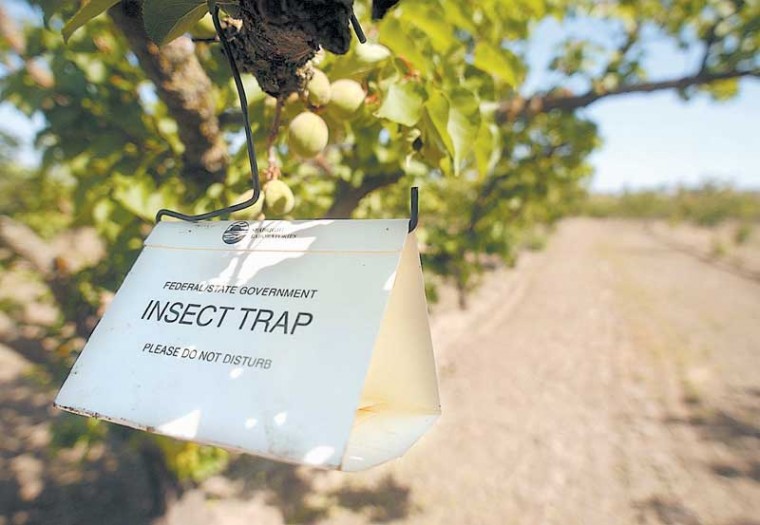
Hollister
– A threat to local fruit crops may be landing in San Benito
County in the form of the light brown apple moth.
Hollister – A threat to local fruit crops may be landing in San Benito County in the form of the light brown apple moth.
The Australian pest is making its way south after being detected in Alameda County in late February. Since then, the invasive moth has demanded quarantines in five Bay Area counties, with Monterey, Santa Cruz and San Mateo counties to be added shortly.
The California Department of Food and Agriculture is working with the Federal Department of Agriculture and county agricultural commissioners to establish specific quarantines on movement of plants where the moth has been found, said Jay Van Rein, a spokesman for the CDFA. Agriculture officials believe the moth, which is unable to fly more than 100 feet at a time, is being spread by people.
Van Rein said the moth has been detected mostly in residential areas, but poses a threat to a variety of commercial crops.
“One thing about this moth that is unusual is it’s not a picky eater,” Van Rein said.
San Benito County Agricultural Commissioner Paul Matulich is worried that it’s only a matter of time before the moth is found here.
“We’re probably going to find it,” Matulich said. “If we don’t it’s going to be a miracle.”
The moth feasts on up to 250 different plants, including cherries, grapes, apricots and apples, Van Rein said.
Bill Coates, a farm adviser with the University of California Cooperative Extension, said the moth’s larvae eat the surface of the fruit, leaving it blemished. An infestation could be a big problem, Coates said.
“With the light brown apple moth, it’s infecting products that are shipped fresh,” Coates said.
Some local growers are worried their products could suffer from an infestation.
Anthony Botelho, a San Benito County Supervisor who grows apples, said the bug could affect the storage of his product. Botelho stores the majority of his apples from September to May, and ships them to S. Martinelli & Company in Watsonville to be juiced.
If the moth damages the apple’s surface, it could leave the fruit susceptible to rot.
“It literally goes from apple to apple, and you face a tremendous amount of loss,” Botelho said.
George Bonacich, president of the San Benito County Farm Bureau and an apricot grower, was in Washington, D.C., with the California Farm Bureau Federation this week meeting with legislators to express the organization’s concerns.
An infestation would hurt the county’s apricot industry, scarring the surface of the fruit and making it unmarketable, Bonacich said.
“I think that we’ve got to get right on this thing and keep it from spreading,” he said. “It could be devastating.”
However, local agriculture officials are taking action.
On Monday, the agricultural commissioner began deploying special traps, laced with light brown apple moth pheromones, to detect the pest. Matulich said there was a delay in receiving the lures for the traps.
“There’s been such a high demand in the Bay Area that they haven’t been able to make the lures fast enough,” Matulich said.
About 70 traps will be set out in residential, rural and farm areas in San Benito County north of Tres Pinos, Matulich said.
The commissioner will begin checking the traps Monday.
If the light brown apple moth is detected, state agriculture officials will take steps with the county to set up specific quarantines.
Under a quarantine, vegetation would have to be approved before it is moved outside of the area. The quarantine would include everything from produce to home lawn clippings, Van Rein said.
“We want to put that kind of plant and product movement to a halt,” he said.
Before February, the pest had never been found in the continental United States. State agriculture officials were alerted to the moth’s presence in Alameda County by a retired University of California at Berkeley entomologist, or bug scientist, Van Rein said.
State officials are developing plans to get rid of the moth, Van Rein said.
It is unknown how well the moth will be able to survive in the California climate and what steps should be taken to abate the newly arrived pest.
“We’re asking for advice from people in Australia and New Zealand who’ve had this bug,” Van Rein said.
Michael Van Cassell covers public safety for the Free Lance. He can be reached at 831-637-5566 ext. 335 or mv*********@***********ws.com.









